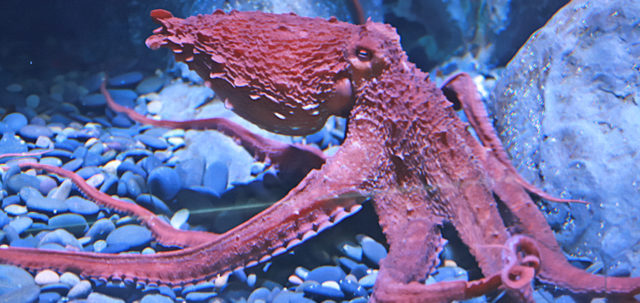“Look at all the tentacles!” I told my youngest daughter, who giggled as she marveled at the Pacific Giant Octopus writhing before us. We were lucky enough to arrive at feeding time, when the animal’s dexterity and size are on full display. Usually it curls up in a ball and simply sits in a corner.
“He’s a big boy!” My daughter exclaimed to a chorus of laughter from myself and the others gazing at the strange, otherworldly creature. Both of my daughters love Cephalopods with all their creepy tentacles and color-change camouflage. Cthulhu is even their favorite monster.
There was another Giant Pacific Octopuses in an adjacent tank but it was curled up in the top corner, barely discernible from the rocks that lined its exhibit walls. Its skin was not the typical bold red of its neighbor but a faded shade that shifted to orange in the valley of every fold and wrinkle. I looked closer and saw the cause of its discoloration; within its knot of tentacles was a cluster of small cream-colored eggs.
This Octopus was about to be a mother. This Octopus was about to die.
A Giant Pacific Octopus lays between 120,000 and 400,000 eggs, folding its body around them as protection from predators and opportunistic scavengers. This dedication comes at a price; while the Octopus is protecting its brood, it does not eat. By the time her babies have hatched, she is already dead.
There is a certain natural symmetry in such a cycle; to bring about new life, the mother must be willing to sacrifice her own. It is tragic and yet beautiful, worthy of meditation especially for us human parents who have the privilege of guiding our young through their young lives and maybe even giving guidance to their offspring as well.
The natural world, it can safely be said, does not care about our opinions. Nature is filled with cruelty and a soul-shattering amount of pain. Consider the spider, who paralyzes its prey before slowly liquefying its insides for nourishment as the helpless creature waits for death; consider likewise the Octopus’ cousin the Reef Squid, which often eats its food tail-first with agonizing nibbling bites from its tiny beak.
There is little guaranteed to us in this life. If we are fortunate, we might have loved ones who care for us and put our own needs above their own. If we are very fortunate, we might also have material security and comfort. In this unpredictable and changing world in which we live, it sometimes seems as though every good thing we have found in this life might, at any moment, be taken from us without any recourse or appeal.
For those baby Octopuses, life must seem filled with chaotic uncertainty. One of the reasons that so many are born at once is because 99% will not reach adulthood because of predation. Those who survive must be very clever and very lucky little Cephalopods to survive as dangerous a home as the ocean.
Octopuses are very clever creatures, capable of problem-solving, recognizing human faces, and using rudimentary tools. Those who survive childhood and adolescence must be very lucky as well; as babies they must avoid filter-feeders, as adolescents they must be watchful for stingrays, sharks, and seals.
It’s not at all scientific but I like to think that some of the wily, watchful ones who survive into adulthood remember the great creature they first saw upon leaving the shelter of their egg, the warm presence that made them feel safe as they developed. Perhaps the female Octopuses draw strength from that memory when the day finally arrives when they, too, make the ultimate sacrifice so that their species might survive.
The Giant Pacific Octopus mother’s legacy is to die so that their children might have life. As I watch my own children grow and learn, develop interests and try new hobbies, I understand, in some small measure, why that Octopus mother I saw at the aquarium is willing to give so much for the lives of so many. I can only hope, as a human parent, to achieve some small measure of such nobility.

